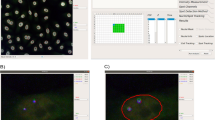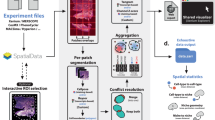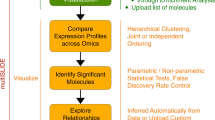Abstract
Fiji is a distribution of the popular open-source software ImageJ focused on biological-image analysis. Fiji uses modern software engineering practices to combine powerful software libraries with a broad range of scripting languages to enable rapid prototyping of image-processing algorithms. Fiji facilitates the transformation of new algorithms into ImageJ plugins that can be shared with end users through an integrated update system. We propose Fiji as a platform for productive collaboration between computer science and biology research communities.
This is a preview of subscription content, access via your institution
Access options
Subscribe to this journal
Receive 12 print issues and online access
$259.00 per year
only $21.58 per issue
Buy this article
- Purchase on SpringerLink
- Instant access to full article PDF
Prices may be subject to local taxes which are calculated during checkout




Similar content being viewed by others
References
Turing, A.M. The chemical basis of morphogenesis. 1953. Bull. Math. Biol. 52, 153–197, discussion 119–152 (1990).
Altschul, S.F., Gish, W., Miller, W., Myers, E.W. & Lipman, D.J. Basic local alignment search tool. J. Mol. Biol. 215, 403–410 (1990).
Myers, E.W. et al. A whole-genome assembly of Drosophila. Science 287, 2196–2204 (2000).
Neumann, B. et al. Phenotypic profiling of the human genome by time-lapse microscopy reveals cell division genes. Nature 464, 721–727 (2010).
Collinet, C. et al. Systems survey of endocytosis by multiparametric image analysis. Nature 464, 243–249 (2010).
Shariff, A., Kangas, J., Coelho, L.P., Quinn, S. & Murphy, R.F. Automated image analysis for high-content screening and analysis. J. Biomol. Screen. 15, 726–734 (2010).
Megason, S.G. & Fraser, S.E. Imaging in systems biology. Cell 130, 784–795 (2007).
Keller, P.J., Schmidt, A.D., Wittbrodt, J. & Stelzer, E.H. Reconstruction of zebrafish early embryonic development by scanned light sheet microscopy. Science 322, 1065–1069 (2008).
Fowlkes, C.C. et al. A quantitative spatiotemporal atlas of gene expression in the Drosophila blastoderm. Cell 133, 364–374 (2008).
Anderson, J.R. et al. A computational framework for ultrastructural mapping of neural circuitry. PLoS Biol. 7, e1000074 (2009).
Saalfeld, S., Cardona, A., Hartenstein, V. & Tomancak, P. As-rigid-as-possible mosaicking and serial section registration of large ssTEM datasets. Bioinformatics 26, i57–i63 (2010).
Murray, J.I. et al. Automated analysis of embryonic gene expression with cellular resolution in C. elegans. Nat. Methods 5, 703–709 (2008).
Fernandez, R. et al. Imaging plant growth in 4D: robust tissue reconstruction and lineaging at cell resolution. Nat. Methods 7, 547–553 (2010).
Bao, Z. et al. Automated cell lineage tracing in Caenorhabditis elegans. Proc. Natl. Acad. Sci. USA 103, 2707–2712 (2006).
Long, F., Peng, H., Liu, X., Kim, S.K. & Myers, E. A 3D digital atlas of C. elegans and its application to single-cell analyses. Nat. Methods 6, 667–672 (2009).
Peng, H. et al. BrainAligner: 3D registration atlases of Drosophila brains. Nat. Methods 8, 493–500 (2011).
Swedlow, J.R. & Eliceiri, K.W. Open source bioimage informatics for cell biology. Trends Cell Biol. 19, 656–660 (2009).
Peng, H. Bioimage informatics: a new area of engineering biology. Bioinformatics 24, 1827–1836 (2008).
Abramoff, M.D., Magalhaes, P.J. & Ram, S.J. Image processing with ImageJ. Biophotonics International 11, 36–42 (2004).
Carpenter, A.E. et al. CellProfiler: image analysis software for identifying and quantifying cell phenotypes. Genome Biol. 7, R100 (2006).
Peng, H., Ruan, Z., Long, F., Simpson, J.H. & Myers, E.W. V3D enables real-time 3D visualization and quantitative analysis of large-scale biological image data sets. Nat. Biotechnol. 28, 348–353 (2010).
de Chaumont, F., Dallongeville, S. & Olivo-Marin, J.-C. ICY: a new open-source community image processing software in. IEEE Int. Symp. on Biomedical Imaging 234–237 (2011).
Berthold, M.R. et al. KNIME: the Konstanz Information Miner. in Studies in Classification, Data Analysis, and Knowledge Organization (GfKL 2007) 319–326 (Springer, 2007).
Cardona, A. et al. TrakEM2 software for neural circuit reconstruction. PLoS One (in the press).
Schmid, B., Schindelin, J., Cardona, A., Longair, M. & Heisenberg, M. A high-level 3D visualization API for Java and ImageJ. BMC Bioinformatics 11, 274 (2010).
Preibisch, S., Saalfeld, S., Schindelin, J. & Tomancak, P. Software for bead-based registration of selective plane illumination microscopy data. Nat. Methods 7, 418–419 (2010).
Preibisch, S., Tomancak, P. & Saalfeld, S. in Proc. ImageJ User and Developer Conf. 1, 72–76 (2010).
Matas, J., Chum, O., Urban, M. & Pajdla, T. Robust wide baseline stereo from maximally stable extremal regions. Image Vis. Comput. 22, 761–767 (2004).
Ibanez, L., Schroeder, W., Ng, L. & Cates, J. The ITK Software Guide (Kitware Inc., 2005).
Köthe, U. Reusable software in computer vision. in Handbook of Computer Vision and Applications Vol. 3 (eds. Jähne, B., Haussecker, H. & Geissler P.) 103–132 (San Diego: Academic Press, 1999).
Preibisch, S., Saalfeld, S. & Tomancak, P. Globally optimal stitching of tiled 3D microscopic image acquisitions. Bioinformatics 25, 1463–1465 (2009).
Cardona, A. et al. An integrated micro- and macroarchitectural analysis of the Drosophila brain by computer-assisted serial section electron microscopy. PLoS Biol. 8, e1000502 (2010).
Bock, D.D. et al. Network anatomy and in vivo physiology of visual cortical neurons. Nature 471, 177–182 (2011).
Kaynig, V., Fischer, B., Müller, E. & Buhmann, J.M. Fully automatic stitching and distortion correction of transmission electron microscope images. J. Struct. Biol. 171, 163–173 (2010).
Saalfeld, S., Fetter, R., Cardona, A. & Tomancak, P. Elastic volume reconstruction from series of ultrathin microscopy sections. Nature Methods advance online publication, doi:10.1038/nmeth.2072 (10 June 2012).
Arganda-Carreras, I. et al. Consistent and elastic registration of histological sections using vector-spline regularization. in Lecture Notes in Computer Science 4241, 85–95 (Springer, 2006).
Lowe, D.G. Distinctive image features from scale-invariant keypoints. Int. J. Comput. Vis. 60, 91–110 (2004).
Sethian, J.A. Level Set Methods and Fast Marching Methods: Evolving Interfaces in Computational Geometry, Fluid Mechanics, Computer Vision, and Materials Science (Cambridge University Press, 1999).
Kass, M., Witkin, A. & Terzopoulos, D. Snakes: active contour models. Int. J. Comput. Vis. 1, 321–331 (1988).
Hall, M. et al. The WEKA data mining software: an update. SIGKDD Explor. 11, 10–18 (2009).
Kaynig, V., Fuchs, T.J. & Buhmann, J.M. Geometrical consistent 3D tracing of neuronal processes in ssTEM data. Med. Image. Comput. Comput. Assist. Interv. 13, 209–216 (2010).
Cardona, A. et al. Identifying neuronal lineages of Drosophila by sequence analysis of axon tracts. J. Neurosci. 30, 7538–7553 (2010).
Longair, M.H., Baker, D.A. & Armstrong, J.D. Simple Neurite Tracer: open source software for reconstruction, visualization and analysis of neuronal processes. Bioinformatics 27, 2453–2454 (2011).
Edelstein, A., Amodaj, N., Hoover, K., Vale, R. & Stuurman, N. Computer control of microscopes using μManager. in Current Protocols in Molecular Biology (John Wiley & Sons, Inc., 2010).
Acknowledgements
We thank W. Rasband for developing ImageJ and helping thousands of scientists, those who contributed to the Fiji movement by financing and organizing the hackathons, namely G.M. Rubin for hackathons at Janelia Farm, I. Baines for hackathons at Max Planck Institute of Molecular Cell Biology and Genetics in Dresden, R. Douglas for a hackathon at Institute of Neuroinformatics in Zurich, F. Peri and K. Miura for the hackathon at European Molecular Biology Laboratory, and International Neuroinformatics Coordinating Facility for Fiji image-processing school, W. Pereanu for the confocal image of the larval fly brain, M. Sarov for the confocal scan of C. elegans larva, the scientists who released their code under open-source licenses and made the Fiji project possible. We want to thank Carl Zeiss Microimaging for access to the SPIM demonstrator. K.E. and C.R. were supported by US National Institutes of Health grant RC2GM092519. J.S. and P.T. were funded by Human Frontier Science Program Young Investigator grant RGY0083. P.T. was supported by The European Research Council Community′s Seventh Framework Programme (FP7/2007-2013) grant agreement 260746.
Author information
Authors and Affiliations
Corresponding authors
Ethics declarations
Competing interests
The authors declare no competing financial interests.
Supplementary information
Supplementary Text and Figures
Supplementary Figures 1–3 and Supplementary Table 1 (PDF 1230 kb)
Supplementary Video 1
Visualization of Fiji development. The video, produced using 'gource' tool in Git, visualizes the changes to Fiji source code repository from 15 March 2009 to 16 May 2009. The class hierarchy is visualized as a dynamic tree, the developers are flying pawns that extend rays to classes that they newly created or into which they introduced changes. Between 23 March and 3 April 2009 there was a Fiji hackathon in Dresden, Germany, marked by increased developer activity that carries over the period after the hackathon ended, the 'hackathon effect'. (MOV 10866 kb)
Supplementary Video 2
Visualization of SIFT-mediated stitching of large ssTEM mosaics. The ventral nerve cord of Drosophila first instar larva was sectioned and imaged in electron microscope as a series of overlapping image tiles. The video visualizes the process of reconstruction of such large section series on seven exemplary sections. The corresponding SIFT features that connect images within section and across section are shown as green dots, the residual error of their displacement at a given iteration of the global optimizer is shown as cyan line (iteration number and minimal, average and maximal error are shown in lower left corner). The global optimization proceeds section by section and at each step distributes the registration error equally across the increasing set of tiles. To emphasize the visualization effect all tiles within section are initially placed at the same location discarding their known configuration within section. (MOV 15759 kb)
Supplementary Video 3
Visualization of bead-based registration of multiview microscopy scan of Drosophila embryo. Drosophila embryo expressing His-YFP marker has been imaged in a spinning disc confocal microscope from 18 different angles improvising rotation using custom made sample chamber. The video visualizes the global optimization that is using local geometric bead descriptor matches to recover the shape of the embryo specimen. The bead descriptors (representing constellations of sub-resolution fluorescent beads added to the rigid agarose medium in which the embryo was mounted) are colored according to their displacement at each iteration of the optimizer (red, maximum displacement; green, minimum displacement). The nuclei of the embryo specimen are shown in grey. The displacement at each iteration averaged across all descriptors is shown in the lower left corner. (MOV 6422 kb)
Supplementary Video 4
Segmentation and tracking of nuclei in Drosophila embryo. Cellular blastoderm stage Drosophila embryo expressing His-YFP marker in all cells was imaged from five angles using SPIM throughout gastrulation. The video shows a result of segmentation and tracking algorithm that follows the movements of cells through the gastrulation process. The nuclei are colored according to the angle at which they were detected. (MOV 13736 kb)
Rights and permissions
About this article
Cite this article
Schindelin, J., Arganda-Carreras, I., Frise, E. et al. Fiji: an open-source platform for biological-image analysis. Nat Methods 9, 676–682 (2012). https://doi.org/10.1038/nmeth.2019
Published:
Issue Date:
DOI: https://doi.org/10.1038/nmeth.2019



